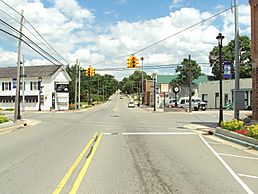Metamora Crossroads Historic District facts for kids
|
Metamora Crossroads Historic District
|
|
 |
|
| Location | Intersection of Oak and High Street Metamora, Michigan |
|---|---|
| Area | 3.5 acres (1.4 ha) |
| Built | 1850–1910 |
| Architectural style | Mix of Greek Revival, Gothic Revival, and Italianate |
| NRHP reference No. | 84001790 |
Quick facts for kids Significant dates |
|
| Added to NRHP | July 19, 1984 |
The Metamora Crossroads Historic District is a special area in the small village of Metamora, Michigan. It's like a time capsule, showing what the village looked like long ago. This historic district is found where Oak and High Street meet. It was officially recognized as a Michigan State Historic Site and added to the National Register of Historic Places on July 19, 1984. This means it's an important place to protect because of its history.
Contents
What Makes the District Special?
This historic district covers about 3.5 acres (1.4 hectares). It includes fifteen buildings, and almost all of them (fourteen) help tell the story of the area's past. These buildings were built between 1850 and 1910. Many of them still serve the same purpose they did over a hundred years ago!
Architectural Styles You'll See
The buildings here show off different styles of architecture. You can spot three main types:
- Greek Revival: This style was popular in the mid-1800s. Buildings often look like ancient Greek temples, with columns and simple, strong shapes.
- Gothic Revival: This style became popular a bit later. It often features pointed arches, steep roofs, and tall windows, like old European churches.
- Italianate: This style was also popular in the mid to late 1800s. Buildings often have low-pitched roofs, wide overhanging eaves, and tall, narrow windows.
Important Buildings in the District
The district has ten commercial buildings (like stores), four houses, and one church. Here are some of the notable ones:
- Ammerman Building / Hoard House (now the White Horse Inn): This building was a village store built in 1850. Today, it's known as the White Horse Inn, Michigan's oldest restaurant that has been open continuously since 1850.
- Barrows Building: Built around 1866, this wooden building was covered in clapboard siding.
- Wilder Brothers Building: This two-story wooden building was constructed around 1870.
- Pilgrim Congregational Church: A beautiful church built in 1878 in the Gothic style.
- Stone Building: A two-story commercial building from 1879, showing Italianate style.
- Metamora Township Hall and Opera House: This red-brick building from 1888 served as a town hall and a place for performances.
- Masonic Lodge: Built in 1907, this two-story brick building was both a store and a meeting place for the Masonic Lodge.
A Look Back: Metamora's History
Metamora was first settled in 1839 by a man named Eber Barrows. The area was even called "Barrow's Corners" at first!
Early Days and Growth
In 1843, Eber Barrows built a log way station. This was a simple place for travelers to rest on their journeys north. A few years later, in 1848, a major road was built through the settlement. This brought more travelers, and soon, other hotels opened up. Barrows updated his way station and called it the Northern Exchange Hotel.
In 1850, Daniel Ammerman built the first store in Barrow's Corners. This building later became Lorenzo Hoard's House, another place for travelers. Around this time, farming became very important. Farmers started raising sheep and growing apples. Metamora became the main center for the farms around it. It had important services like a blacksmith, a wagon shop, and even two doctors.
Railroad and New Buildings
In the late 1860s, more commercial buildings were constructed. A big change happened in 1872 when the Detroit and Bay City Railway built a train line through the village. This made Metamora an important hub for sending local farm goods to other places.
Over time, new brick commercial buildings replaced older wooden ones. New churches and schools were also built. In 1888, the Town Hall and Opera House was completed. More structures were added until about 1910.
Changes in the 20th Century
When cars became popular in the 1910s, Metamora started to lose some residents. People moved to bigger cities like Flint and Pontiac for work.
By the 1920s, new owners in the countryside started breeding horses and running hunt clubs. Even with fewer people, the village shops stayed open. They continued to provide convenient shopping for the people who lived there. The main part of the village stopped growing before World War I. This means that the old buildings and their early architecture were preserved, giving us a glimpse into the past today.



